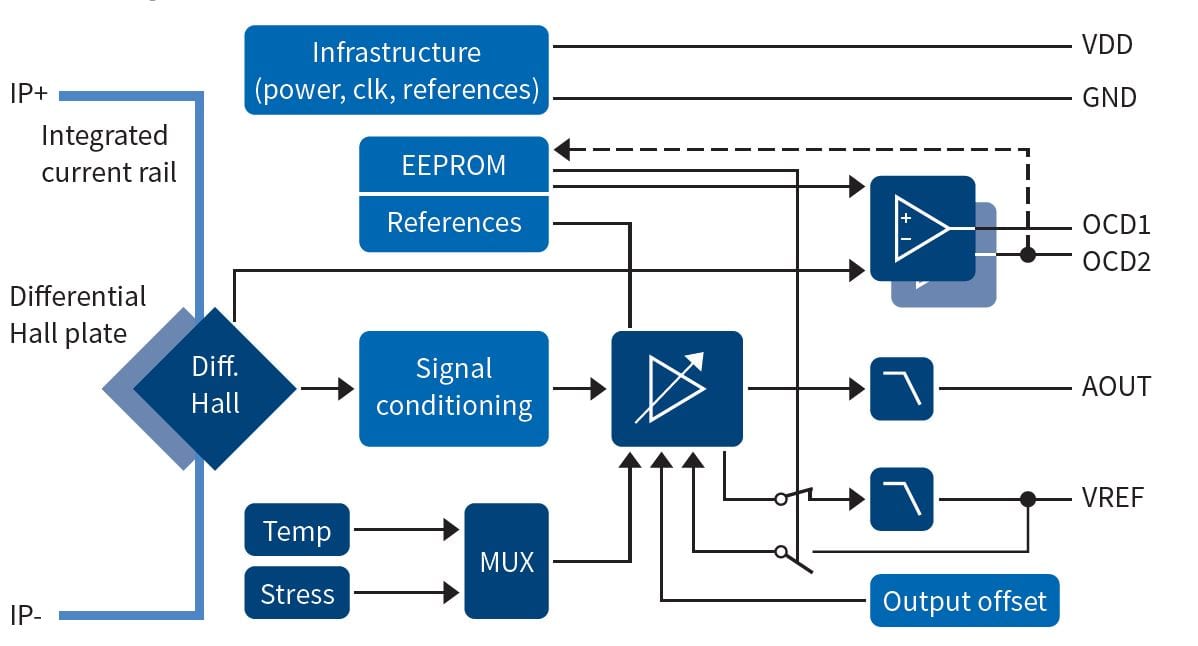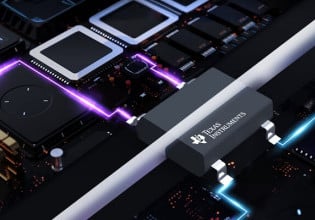Precise and Robust Current Sensing – Infineon’s new XENSIV TLI4971 is suited for currents up to 120A
By Jutta Heinzelmann, Manager Product Marketing, Magnetic Current Sensors and Theodor Kranz, Application Engineer, Magnetic Current Sensors at Infineon Technologies
It is vital for information on current flow in electronic systems to be as detailed as possible in various applications - from solar inverters and electric drives to power supply equipment, server and telecom systems, lighting management and household appliances and electric and hybrid vehicles. The demand for industrial current sensors is therefore continuously growing, whereby every application has its own criteria in regard to accuracy (both in absolute terms and over the product lifetime), suppression of interference fields, measurement range, power dissipation, bandwidth, dimensions and cost.
The applications involved require sensors that take up the least possible space, incur low losses, and deliver a highly precise, robust and safe operation over their entire life cycle. The Hall-based current sensor XENSIVTM TLI4971, the first member of a new current sensor family from Infineon, meets all of these requirements.
Magnetic field-based sensors can be divided basically in open-loop and closed-loop (compensation current converter) configurations. In an open-loop system with a toroidal core the primary current generates a magnetic field, which is converted into a measurement voltage by a magnetic sensor. In this case, the magnetic flux induced by the primary current is concentrated in the magnetic circuit. In a closed-loop system the magnetic flux generated by the primary current is compensated by means of a secondary winding, and a magnetic sensor with appropriate electronic circuitry is used to control the compensation current.
Core-based techniques have disadvantages in regard to core losses, saturation and hysteresis effects, as well as long-term drift. Compared to traditional systems with magnetic cores serving as field concentrators the "coreless" current sensor XENSIV TLI4971 does not exhibit any of these negative effects. In addition, this sensor offers an integrated self-diagnosis function. Infineon's proven and robust Hall technology enables precise and highly linear current measurements up to +120A.
The analog circuit concept, in combination with a specific digital stress and temperature compensation method, ensures excellent stability in regard to temperature and the entire life cycle. The analog output signal shows a constant group delay across the temperature range. In addition, the differential measurement principle allows the suppression of stray fields, and thus operation in harsh environments. The integrated primary conductor (current bar) with its very low resistance of 225µΩ results in minor power losses, and it enables a compact sensor layout.
Highly precise miniaturized current sensor
Infineon's XENSIV TLI4971 is a very precise current sensor for bidirectional ac and dc measurements. It offers an analog interface and two additional outputs for a fast indication of overcurrents. The contactless measurement principle without a magnetic core, as well as the integrated insulation layer ensure the secure galvanic isolation. Furthermore, the contactless measurement principle causes no additional losses and is therefore well suited for energy-efficient designs.
With its comprehensive feature set, the XENSIV TLI4971 can be deployed in manifold industrial applications (Figure 1). The spectrum extends from general ac inverters to photovoltaic inverters, robotic systems, charging stations, battery management and smart metering to power tools and household appliances.
 Figure 1: The highly precise and robust current sensors are laid out for manifold industrial applications.
Figure 1: The highly precise and robust current sensors are laid out for manifold industrial applications.
Besides achieving an accurate current measurement, a very efficient protection of the power output stage can be implemented, since external short-circuits, for instance, could lead to critical overcurrents. To achieve its extremely short latency period, the TLI4971 offers a parallel signal path. The overcurrent thresholds can be optimally adapted to the prevailing application requirements, with the system developer programming the current value as well as the downstream glitch filter.
The sensor is delivered completely calibrated, eliminating any cumbersome calibration process for the customer.
Space and cost saving design
 Figure 2: TLI4971 is housed in a compact PG-TISON-8 package measuring 8 mm x 8 mm x 1 mm. It is suited for automatic SMT assembly.
Figure 2: TLI4971 is housed in a compact PG-TISON-8 package measuring 8 mm x 8 mm x 1 mm. It is suited for automatic SMT assembly.
The TLI4971 is offered in the especially compact TISON (Thin Interstitial Small Outline No leads) SMD package whose dimensions are just 8mm x 8mm x 1mm (Figure 2). The miniaturized package of the TLI4971 weighs only 0.2 grams. The TISON SMD package allows for automatic printed-circuit board assembly and makes it cost-efficient. Together with all the integrated functionality in the form of filters, overcurrent compensators and galvanic isolation, it is possible to significantly reduce not just the space requirements but also the cost of materials (BOM).
The specific layout of the current bar results in an excellent thermal behavior with currents up to 120A - without incurring additional costs. The sensor is designed for high-voltage applications and is galvanically isolated against voltages up to 1.15kV (VIORM).
Structure and function principle
Figure 3 shows a block diagram of the XENSIV TLI4971. A current flow through the current bar on the primary side induces a magnetic field, which is measured by the two differential Hall elements. A powerful amplifier combines the differential field signal with the compensatory information stemming from the temperature and stress measurement. Finally, the output signal is delivered with a high bandwidth of 120kHz.
 Figure 3: TLI4971 block diagram. (click on diagram to enlarge)
Figure 3: TLI4971 block diagram. (click on diagram to enlarge)
Depending on the programming option, the analog output signal can be single-ended and fully differential, or semi-differential. In the single-ended option, the analog signal is delivered at the AOUT pin, with VDD serving as the reference voltage input. In fully differential mode, both AOUT (positive polarity) as well as VREF (negative polarity) are used as signal outputs to double the output signal swing. The differential measurement principle compensates the noise impacting both analog output signals (Figure 4). In semi-differential configuration an internal reference voltage is used. It is provided via VREF. The captured current value is delivered via AOUT. For a bidirectional current measurement the reference voltage is placed in the center of the dynamic range. To accommodate current measurements without sign change the reference voltage can be adjusted according to the lower or upper limit of the dynamic range.
 Figure 4: Application circuitry for a three-phase system in fully differential configuration. (click on diagram to enlarge)
Figure 4: Application circuitry for a three-phase system in fully differential configuration. (click on diagram to enlarge)
Fast overcurrent protection
XENSIV TLI4971 offers two output terminals (OCD1, OCD2) for overcurrent signals (see also Figure 3). They can be used for an advance warning or a system shutdown in case of impending destruction. To enable this function, users can program appropriate threshold voltages for the overcurrent signals, and they can adapt them to their systems' operational conditions so that there are no additional external components needed. In addition, the sensor will output specific signals in case of an overvoltage or overcurrent of the supply voltage.
An independent signal path in parallel to the analog output path allows for a fast and reliable detection of possible overload currents. The symmetrical thresholds are adjustable for both outputs (OCD1 and OCD2). They will trigger an overcurrent event for a positive or a negative overcurrent. A user-programmable glitch filter has been implemented to suppress fast switching transients.
The separate internal signal path for overcurrent detection allows a very fast response time of typically 1.5µs. When connected with the logic input of a microcontroller the OCD pins can trigger an interrupt in the microcontroller and, if needed, switch off the system to protect it against damage. The open-drain architecture makes it possible to connect the OCD pins of several XENSIV TLI4971 sensors with a single input pin of a microcontroller.
Flexibility for manifold applications
Thanks to its flexible configuration the sensor can be adapted to various applications. This concerns the measurement range, OCD thresholds, delay times and output modes. These are stored in an EEPROM and accessible to the user. It can be programmed in the field via a serial interface.
 Figure 5: Application example: the new current sensors are ideally suited for phase current measurement in motor drives.
Figure 5: Application example: the new current sensors are ideally suited for phase current measurement in motor drives.
A typical application is phase current measurement in drives (Figure 5). They require appropriate motor controls, protection of the output stages against overcurrents, precise current measurements in harsh environments, high-voltage galvanic isolation and robustness against steep voltage transients. In this regard, the TLI 4971 device offers an accuracy of less than three percent across the temperature range and life cycle, two independent output terminals for overload detection, high robustness against stray fields, as well as galvanic isolation between current bar and sensor. In terms of system design this means that no shielding is necessary, the layout is simplified and, as a result, there will be substantial space and cost savings. Performing a simple calibration at room temperature will reduce the measurement error to below two percent. In addition, the differential measurement via those two Hall cells enables high accuracy, even in noisy environments with cross talk from adjacent current lines.
Availability
The first available member of the new current sensor family, the XENSIV TLI4971, will measure currents up to 120A. It is laid out for manifold industrial applications, such as motor drives up to 50kW or photovoltaic inverters. Additional products of this sensor family will be introduced in 2020 - among which will be versions qualified for automotive electronics. Production of the TLI4971 is planned for September 2019. Infineon presented appropriate development tools at Sensor & Test 2019 (June 25 to 27) in Nuremberg, Germany. More information will be available here at the start of production.






